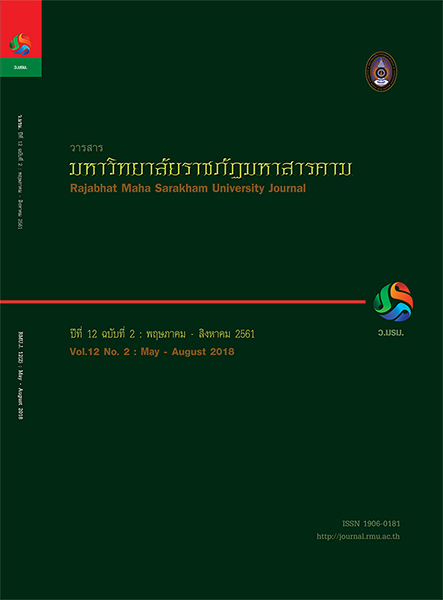Causal Factors and Ways to increase Efficiency. Quality Learners in Opportunity Expansion Schools under the Office of Basic Education Commission
Main Article Content
Abstract
This paper reports in the aims of research study were to investigate the effectiveness level on learner
qualities, to determine the causal factors and increasing the effectiveness guidelines of learner qualities, to
develop and validate causal model of multi-level factors that influence the effectiveness, and to promote the
increasing the effectiveness guidelines of learner qualities in the Opportunity Expansion Schools under the
Office of Basic Education Commission were the main purposes. Administrations of the sample consisted of
1,122 teachers who taught and students who sat at the 9th grade level in 33 schools with the Multistage Random
sampling technique. Using both the high quality of the research instruments was validated and reliable with
the questionnaire evidence of 0.912, to measure achievement motivation confidence of 0.906 and attitude test
with a confidence of 0.908, respectively. Statistically significant analyzed with the descriptive statistics and
confirmatory factor analysis (CFA), the multilevel confirmatory factor analysis (MCFA) and structural equation
modeling analysis and the study of ways to promote the effectiveness guidelines of learner qualities in the
opportunity expansion schools with seminar was based on the expert connoisseurship both quantitative and
qualitative data were analyzed. The results of the research findings as the effectiveness guideline level indicated
as a whole at the medium level. The causal factors of learning motivation and attitude towards students’
learning outcomes were related at the high level. The causal factors were also found between increasing the
effectiveness guidelines of learner qualities and their motivation and attitude towards to their learning outcomes
with the learning processes were consistency with the empirical data (=124.724, df = 111, P = 0.1762, CFI
= 0.998, TLI = 0.998, RMSEA = 0.011, SRMRW = 0.029, SRMRB = 0.133, and = 1.123). The effect sizes and
influences considered directly as the highest evidence of 0.919, 0.792, and 0.292 with their affecting learning
processes, attitudes, achievement motivations at the relation level of 0.01, respectively. The guidelines for
learning processes consisted of four main components that followed as: introduction, the thinking processing
knowledge, practical schooling guideline, and practical classroom guideline. The assessing experts were
evaluated to qualify causal factors and increasing the effectiveness guidelines of learner qualities to their
appropriateness and feasibility are provided at the highest level, interestingly.
Article Details
1. All articles undergo a thorough with at least three reviewers evaluating their suitability within the respective field of study, during the double-blind review.
2. The views expressed by individual authors do not represent the official views of the Editorial Boards of RMUJ: The author of each articie is responsible for all its contents.
3. The Editorial Boards do not reserve the copyrights. but proper citations need to be made.
References
the quality of secondary education to international
standards.Annual 2016. Retrieved from https://
drive.google.com/file/d/.0Bx2cUxE8N736MkRpV0
xVYVV4MW8/ view.
[2] TheNational Education Testing Institute. (2016). The
results of the national educational tests basic
(O-NET) at the 3rd grade level students in BE 2558.
Retrieved from www.onetresult.niets.or.th/
[3] Wongwanich, Suwimol. (2007). Research projects
accelerate the positive attributesofyouth,Thailand
complete. Bangkok : Prig Whaun Graphics Co
[4] Wiratchai, Nonglak. (2002). The process of reform
to improve the quality of learning : Evaluation
and assurance. Bangkok : VTC Communications
applications.
[5] Kanjanadee, chayanit. (2013). The analysis of the
factors influencing the academic achievement of
students in the sixth grade at the three
southernmost provinces. Master of Arts Thesis
Academic Evaluation and Research Studies
Songkla University.
[6] Rooncharean, Teera. (2002). The research report
titled : The state and the administration and
management of basic education schools in the
country. Bangkok : VTC Communications Ltd.
[7] Kangpheng, Sumrit. (2008). Factors that
influence the effectiveness of school
management : The development and validation
of the models. Postdoctoral thesis. Graduate
College University.
[8] Hair, J. F., Black, W. C., Babin, B. J., & Anderson,
R. E. (2010). Multivariate data analysis : A global
perspective. (7th ed). New Jersey : Pearson
Education Inc.
[9] Linderman, R.H., Merenda, P.F., & Gold, R.Z. (1978).
Introduction to bivariate and multivariate
analysis. London : Scott, Foresman.
[10] Wongchai, Jatuporn. (2014). Multiple factors
affect the results of the national test of basic (ONET)
: Mathematics Grade 6th level, the OES
schools under the Primary Educational Service
Area Office 3. Year 4 No. 7 July to December.
Journal of Science Education Network Northern
Rajabhat University.
[11] Kawmongkon, Songyot.( (2013). Factors
Influencing Academic Affairs Administration
Effectiveness of Primary School under the
Bangkok Metropolitan Administration.
Department of Educational Administration, Faculty
of Education, Kasetsart University

